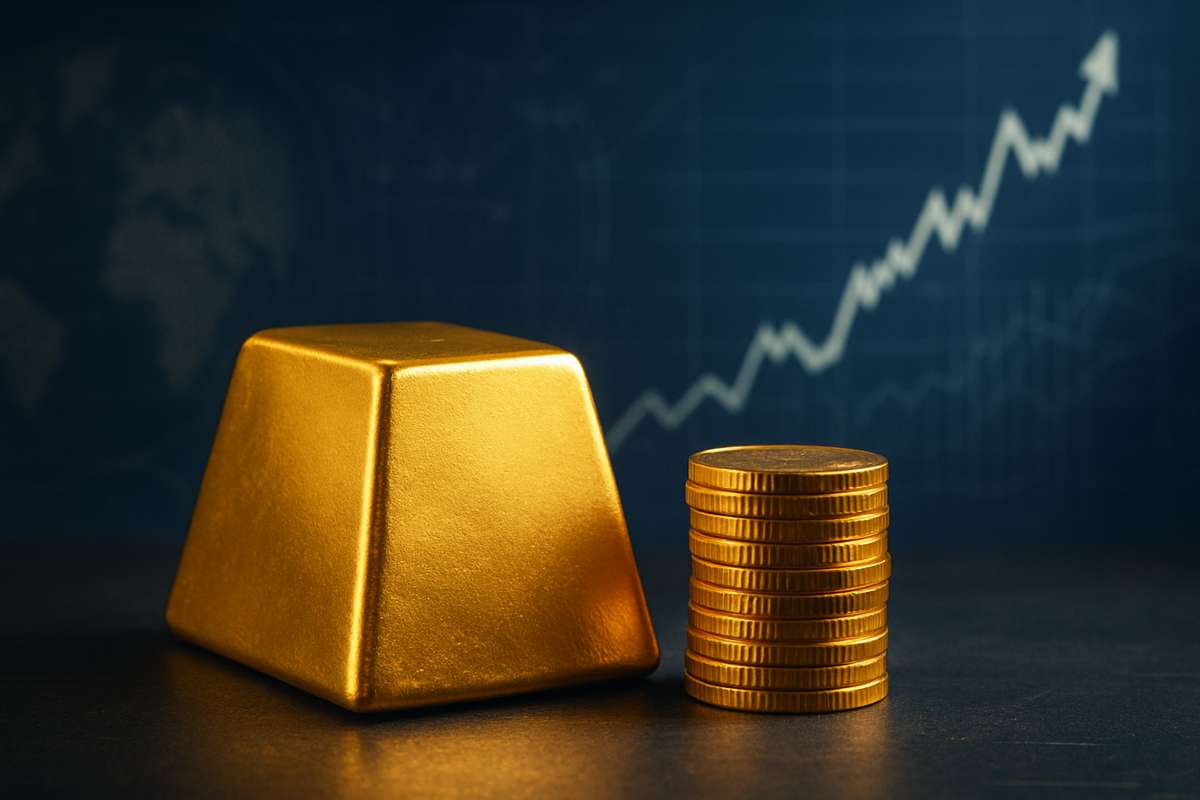
In a significant pronouncement that has sent ripples through the financial markets, veteran market strategist Ed Yardeni has declared gold the "new Bitcoin" and the preeminent safe-haven asset for investors navigating an increasingly turbulent global landscape. His bold assertion comes amidst a spectacular surge in gold prices throughout 2025, capturing investor attention and prompting a reevaluation of traditional investment strategies. Yardeni’s analysis suggests a fundamental shift in how investors should view and utilize precious metals as a hedge against geopolitical instability, trade tensions, and de-dollarization trends.
This recharacterization of gold marks a pivotal moment, challenging the narrative that has long positioned cryptocurrencies, particularly Bitcoin, as the ultimate digital store of value. Yardeni's endorsement of gold as a superior safe haven underscores its enduring appeal and historical resilience, positioning it as a critical component of diversified portfolios in an era he describes as a "new world disorder."
Gold's Ascent: A Detailed Look at Yardeni's Thesis and Market Dynamics
Ed Yardeni, president of Yardeni Research, articulated his conviction that "Bitcoin has been described as 'digital gold,' but we would describe gold as 'physical bitcoin.'" This statement encapsulates his belief in gold's tangible, time-tested reliability over the speculative volatility often associated with cryptocurrencies. Gold's massive rise in 2025, with year-to-date gains reported between 50-60% and prices surpassing $4,000 per ounce, even touching highs above $4,200, provides the robust backdrop for his argument.
The timeline leading up to this moment reveals a confluence of powerful macroeconomic and geopolitical forces. Escalating geopolitical uncertainties, including heightened global tensions and President Donald Trump's threats of new, significant tariffs against China, have consistently pushed investors towards traditional safe-haven assets. A critical factor has been the accelerating trend of central bank de-dollarization; following events such as the freezing of Russia's foreign exchange reserves, central banks, particularly those in nations with strained relations with the U.S., have aggressively accumulated gold, diversifying away from dollar reserves. Furthermore, the bursting of China's housing bubble has prompted a significant shift of household savings into gold as a stable alternative, while gold's traditional role as an inflation hedge also contributes to its appeal, even as inflation has moderated.
Yardeni contrasts gold's steady appreciation with Bitcoin's more volatile "risk-on" behavior, highlighting instances where Bitcoin experienced significant declines due to liquidations in leveraged positions, while gold continued its upward trajectory. He acknowledges Bitcoin's speculative allure but maintains his long-held skepticism, having previously referred to cryptocurrencies as "digital tulips." His bullish outlook for gold is substantial, projecting prices to reach $5,000 per ounce in 2026 and potentially soaring to $10,000 per ounce by the end of the decade or by 2028-2030, representing a potential gain of approximately 150% from current levels. This long-term view solidifies gold's position not just as a short-term hedge but as an asset with profound appreciation potential.
Corporate Fortunes Tied to the Golden Surge
The dramatic surge in gold prices and Ed Yardeni's bullish forecast carry significant implications for various public companies across the financial and mining sectors. Companies directly involved in gold extraction and production are poised to be major beneficiaries, experiencing enhanced profitability and potentially increased investment.
Leading gold mining companies such as Barrick Gold Corp. (NYSE: GOLD) and Newmont Corp. (NYSE: NEM) stand to gain substantially. Higher gold prices directly translate into increased revenues and wider profit margins for these firms, allowing for greater capital expenditures, debt reduction, or increased shareholder returns through dividends and buybacks. Exploration companies and junior miners may also see renewed interest and investment, as the economics of previously marginal projects become more attractive. Conversely, companies that rely heavily on stable commodity prices or those with significant exposure to inflationary pressures might find gold's rise a mixed blessing, as it signals broader economic uncertainties.
Beyond the mining sector, financial institutions dealing in commodities, exchange-traded funds (ETFs) focused on gold, and wealth management firms recommending asset allocation strategies will also be affected. Gold-backed ETFs like SPDR Gold Shares (NYSEARCA: GLD) have likely seen massive inflows, benefiting their operators. Brokerage firms and investment banks with strong commodities trading desks could see increased activity and revenue. Furthermore, companies offering secure storage solutions for physical gold, such as vaults and specialized logistics providers, might experience a boost in demand for their services. For companies sensitive to inflation, gold's performance as an inflation hedge could indirectly impact their cost structures and pricing power, compelling them to adapt their financial strategies to a potentially more inflationary environment.
Wider Significance: A Reordering of Global Assets
Ed Yardeni's pronouncement on gold's ascendancy is not merely a market call; it signifies a potential reordering of global asset preferences and reflects profound shifts in broader industry trends. The emphasis on gold as the "new Bitcoin" indicates a growing skepticism towards purely digital, unregulated assets as ultimate safe havens, particularly in times of heightened systemic risk. This event fits into a broader trend of de-globalization and increasing geopolitical fragmentation, where nation-states and investors alike are seeking tangible, universally accepted stores of value that are less susceptible to sanctions or digital vulnerabilities.
The ripple effects on competitors and partners are substantial. For cryptocurrencies, particularly Bitcoin, Yardeni's stance presents a challenge to their long-held narrative as "digital gold." While Bitcoin retains its speculative appeal, its volatility and susceptibility to liquidity events, as highlighted by Yardeni, may prompt a segment of "risk-off" investors to reconsider its safe-haven credentials in favor of gold. This could lead to a divergence in investor bases, with gold attracting more institutional and conservative capital seeking stability, while Bitcoin continues to draw speculative and tech-oriented investors. Traditional safe havens like government bonds may also face scrutiny if inflation persists or if sovereign creditworthiness is questioned, potentially driving even more capital into gold.
Regulatory and policy implications are also significant. A sustained shift towards gold could prompt increased regulatory interest in the physical gold market, potentially leading to new reporting requirements or efforts to standardize trading practices globally. The trend of central bank de-dollarization, a key driver for gold, has broader implications for international finance and the future of the U.S. dollar's reserve currency status, pushing policymakers to address underlying economic and geopolitical tensions. Historically, gold has always served as a crisis hedge, from ancient civilizations to modern financial crises. This current surge echoes periods of high inflation or geopolitical instability in the 1970s and early 2000s, reinforcing its role as a timeless refuge when confidence in fiat currencies or political stability wanes.
What Comes Next: Navigating the Golden Era
The implications of gold's meteoric rise and Ed Yardeni's endorsement are far-reaching, setting the stage for significant shifts in investment strategies and market dynamics in the short and long term. In the immediate future, investors are likely to continue allocating capital towards gold, driven by persistent geopolitical tensions, central bank buying, and the ongoing search for inflation hedges. This could lead to continued upward price pressure, potentially pushing gold towards Yardeni's initial 2026 target of $5,000 per ounce sooner than anticipated.
In the long term, the sustained demand for gold as a strategic asset by both institutional and retail investors could fundamentally alter its market positioning. We might see a permanent re-rating of gold, where its price floor is elevated, reflecting its enhanced role in a de-globalizing and uncertain world. This could necessitate strategic pivots for asset managers, who may need to increase their gold allocations in diversified portfolios, moving away from a purely tactical play to a more foundational one. For companies, particularly those in the mining sector, this signals a period of potential expansion and increased capital investment, as higher prices make more challenging reserves economically viable.
Market opportunities will emerge for innovative financial products tied to gold, such as new gold-backed digital tokens or derivatives that offer more flexible exposure to the metal. Challenges, however, will include managing increased price volatility as gold attracts more speculative interest, and ensuring adequate supply to meet surging demand. Potential scenarios range from a continued, steady appreciation driven by fundamental demand to more volatile swings influenced by geopolitical flashpoints. A key outcome could be a diminished role for traditional fiat currencies as primary safe havens, with gold reclaiming its historical mantle as the ultimate store of value.
The Golden Standard: A Comprehensive Wrap-Up
Ed Yardeni's emphatic declaration of gold as the "new Bitcoin" and the premier safe-haven asset marks a significant recalibration of market sentiment and investment priorities. The key takeaway from this event is gold's undeniable resurgence as a critical component of global financial stability, driven by a complex interplay of geopolitical instability, de-dollarization efforts by central banks, and a flight to tangible assets amidst economic uncertainties. Gold's impressive performance in 2025, surpassing $4,000 an ounce, is not merely a transient rally but, according to Yardeni, the beginning of a sustained upward trend that could see prices reach $10,000 per ounce by the end of the decade.
Moving forward, the market is likely to increasingly view gold through a strategic lens rather than just a cyclical one. Its role as a "buffer against all the craziness" and a "very good hedge against chaos" will likely solidify, influencing asset allocation decisions across institutional and retail investor segments. The comparison to Bitcoin serves to highlight gold's proven track record and less speculative nature, potentially drawing capital away from the more volatile cryptocurrency market into the stability of the precious metal.
The lasting impact of this shift could be a re-establishment of gold as the bedrock of global financial portfolios, providing a tangible hedge against the uncertainties of a rapidly evolving world order. Investors should closely watch central bank gold purchases, geopolitical developments, and inflation indicators, as these factors will continue to be primary drivers of gold's performance. The sustained bullish outlook from a respected market veteran like Ed Yardeni suggests that the golden era for this ancient asset may just be beginning, demanding a careful reassessment of its role in every well-diversified portfolio.
This content is intended for informational purposes only and is not financial advice





